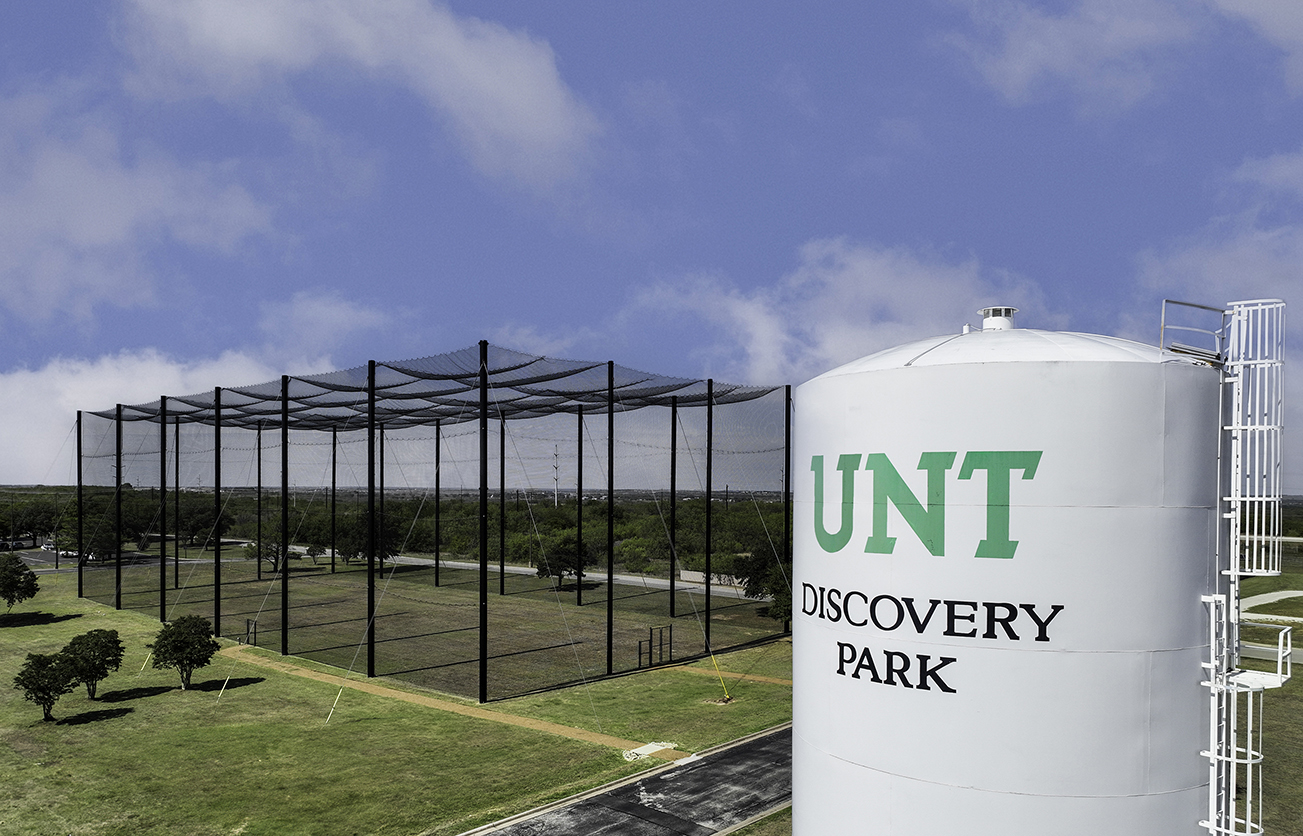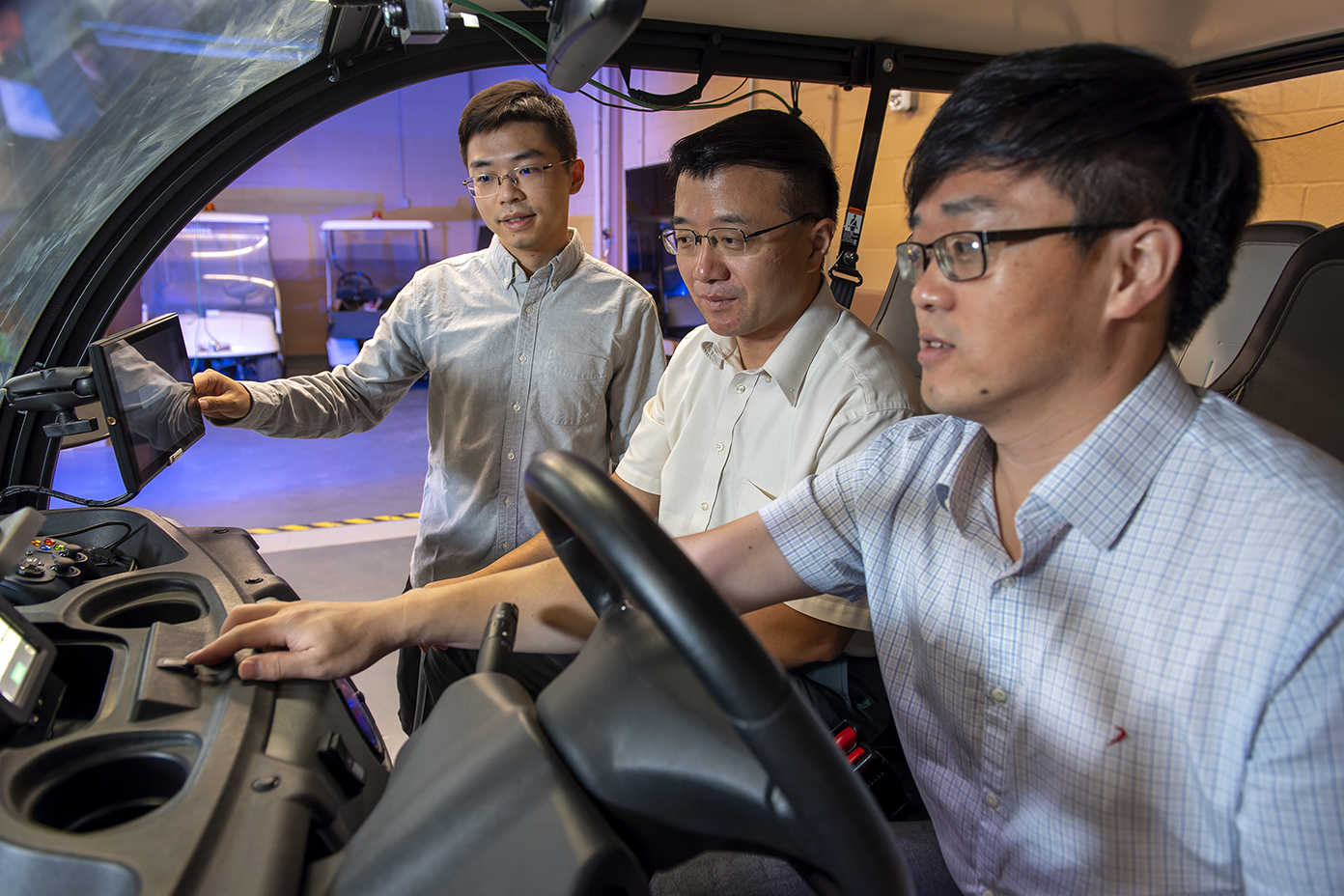One day soon, uncrewed air ambulances could more quickly get help to an accident scene or speed up delivery times for donated organs and human tissue for life-saving transplants. Uncrewed aerial vehicles (UAVs) could play a crucial role in the nation’s supply chain, delivering goods and people through established air routes or “highways in the sky.”

Researchers at the University of North Texas are finding solutions to make those possibilities a reality through projects supported by several government agencies, including the U.S. National Science Foundation, NASA, U.S. Department of Defense and the Texas Department of Transportation.
The work is part of UNT’s Center for Integrated Intelligent Mobility Systems (CIIMS), an interdisciplinary research effort that is paving the way for the future of transportation and mobility by creating solutions for the complexities of devices such as autonomous ground vehicles and UAVs.
Affiliated center researchers from UNT’s College of Engineering and G. Brint Ryan College of Business study the technology itself as well as the data, logistics and policies affecting its development.
CIIMS is a hub between basic research, translational research and corporations to deploy intelligent mobility systems, establish an agile manufacturing process and build the skilled workforce to meet the needs of an autonomous future powering tomorrow’s Texas, nation and world.
Facilities & Expertise
UNT is home to exceptional facilities that will help it reach new heights in this transportation and mobility research. Some of the world’s most state-of-the-art machinery for additive manufacturing is available in the Center for Agile and Adaptive Additive Manufacturing (CAAAM) at UNT’s Discovery Park, the largest research park in the North Texas region. Additive manufacturing technology is transforming the industry and could play a significant role in helping manufacturers more rapidly produce autonomous technologies.
Then, through the UNT Advanced Air Mobility (UAAM) test facility, which officially opened in March 2024 at UNT’s Discovery Park, researchers can experiment with new UAV technology. Standing at 80 feet tall, 120 feet long and 300 feet wide, the sprawling 36,000-square-foot UAAM facility is the largest of its kind in Texas and one of the biggest nationally.
At the facility, UNT researchers and external collaborators can analyze drones to learn how specific maneuvers impact performance; explore safety measures like collision avoidance; and test communication between UAVs and stationary receivers or autonomous vehicles on the ground.
“This drone testing facility really positions UNT as a leader in advanced air mobility research,” says Terry Pohlen, senior associate dean of the Ryan College of Business, director of UNT’s Jim McNatt Institute for Logistics Research and CIIMS co-director. “It allows us to take these new innovations, new applications and test them out in a controlled environment.”
Emergency Communication
Communication is vital for facilitating relief operations immediately after natural or man-made disasters. However, cell towers often become overloaded or cease functioning altogether during emergencies or major public events.
Integrating intelligent mobility and communications into the operations of first responders is at the core of multiple CIIMS projects, including one that is establishing a smart and connected ecosystem for the first-responder community.
Electrical engineering professor Kamesh Namuduri is leading the project — funded by a $1.5 million NSF grant — that’s focused on better understanding how information is shared between different teams and agencies working on disaster relief operations.
“Disasters such as hurricanes can have catastrophic impact on lives and infrastructure,” Namuduri says. “Our goal is to make the response efforts faster and more efficient.”
“Disasters such as hurricanes can have catastrophic impact on lives and infrastructure. Our goal is to make the response efforts faster and more efficient.”
- Kamesh Namuduri, electrical engineering professor
Contributing faculty members Ila Manuj (supply chain management) and Dipakkumar Pravin (information technology and decision sciences) in the Ryan College of Business are looking at current communications on the ground at the individual and organizational level. Previous reports from agencies, such as FEMA and the National Emergency Communications Plan, suggest that current technologies in place cannot meet the desired levels of performance set by the U.S. Department of Homeland Security.
“Understanding interactions, such as information acquisition and resource allocation, during large-scale operations will enable the most effective integration of advanced technologies into these operations,” Manuj says.
At the same time, Namuduri and Maurizio Manzo, mechanical engineering associate professor, are studying how technology could aid in disaster relief operations and other rescue efforts. One example is substituting a nonfunctioning cell tower with a cellular base station airlifted by drones. Moreover, drones equipped with sensor systems such as imaging, infrared and chemical sensors, could survey the area and assess the extent of damage as crews work to locate stranded victims.
“Our commitment to preserving human life and enhancing rescue operations profoundly resonates in this project,” Manzo says. “Even a faster response by just a few seconds can save more lives.”
In a separate project, Namuduri is exploring how to manage the airspace for drones to fly from point to point, which could speed up emergency response times and help connect citizens in even the most remote areas to emergency care. The work is part of NASA’s Advanced Air Mobility National Campaign Project, which is focused on bringing the U.S. closer to an operational high-demand air route for uncrewed, autonomous cargo- and passenger-carrying air transportation.
The UNT research team and their external collaborators previously tested an uncrewed air taxi concept using a surrogate aircraft in an air corridor between Discovery Park and Hillwood’s AllianceTexas Flight Test Center in Justin. That project unites a group of 15 entities, including representatives from UNT, Bell Textron, Unmanned Experts Inc., AAMTEX, Hillwood, NASA and the Federal Aviation Administration.
“In the future, we are going to see a lot of autonomous vehicles. And if we are guaranteeing the safety and security of people and infrastructure, then we are going to see a lot of scaling up, thousands of vehicles are going to fly,” Namuduri says. “At UNT, we are the pioneers in this new technology and are seeking to make this vision a safer, better future reality for all of us.”
Autonomous Vehicles
UNT computer science and engineering professor Song Fu, who is affiliated with CIIMS, is leading a research team in developing a self-driving car powered by AI and deep learning programs.
Researchers have installed various sensors on the car capable of taking 2D pictures and creating 3D point clouds, a series of points in a space that creates a 3D outline of an object like a car or pedestrian. The team doesn’t want the car to be solely self-reliant though. They’re also working on how autonomous cars can share their sensor data to communicate with one another.

“This way, multiple cars can sense an object that a single car may not have picked up on — for example, a person using a crosswalk or an upcoming accident on the side of the road,” Fu says.
Along with communication between vehicles, Fu and his team are working on ways transportation infrastructures, such as traffic lights, can send data to vehicles. Similar to communicating with other cars, this would allow a car to know of approaching objects a traffic light camera might pick up that the car can’t.
The car research is supported by a $2.25 million grant through the NSF’s Industry University Cooperative Research Centers Program and conducted through the Center for Electric, Connected and Autonomous Technologies for Mobility (eCAT), a national effort to foster more collaboration in the development of emerging vehicle technologies.
As the UNT lead for eCAT, Fu is working with his UNT colleagues — along with researchers at Wayne State University, Clarkson University and University of Delaware — to leverage research across academic disciplines and industry expertise to transform the future of mobility and train the next generation of the workforce in this area.
“Electric, connected and autonomous vehicle technologies are the future of ground transportation and it’s going to take a concerted, cooperative effort to bring this technology to the mainstream,” Fu says.
Logistics Innovation
Collaboration will be key in improving the nation’s supply chain. As the largest inland port, the North Texas region and UNT are poised to lead change in logistics and autonomous systems. Currently, more than 900 million tons of freight valued at more than $1.1 trillion annually moves through the region, employing more than 450,000 workers.
Autonomous vehicle and aerial drone technologies are becoming a critical component to solving supply chain issues. However, while these technologies are progressing rapidly, an integrated system that merges the logistics and supply chain infrastructure does not yet exist, and current mobility systems are dependent on foreign technology and manufacturing.
Manuj, Namuduri and Pohlen have been working on various projects funded by NASA, the U.S. Air Force and North Central Texas Council of Governments. These projects are examining the supply chain and engineering challenges related to drones, such as the gaps that need to be addressed for high-volume drone manufacturing. Additionally, they are creating processes for commercialization of UAVs and components.
“What we’re doing here at UNT and with our regional collaborators is at the very forefront of the transformation in transportation, mobility and logistics.”
Terry Pohlen, director of UNT's Jim McNatt Institute for Logistics Research
In 2023, UNT also became the lead institution on a $1 million grant from the NSF Regional Innovation Engines program. The network of organizations called the Texoma Logistics Innovation Engine is collaborating to advance the workforce and mobility systems in the Texoma region, which covers 26 counties and is bordered on the south by the Dallas-Fort Worth area and north by the Choctaw Nation in Oklahoma. It includes participation by UNT, Southern Methodist University, the University of Texas at Arlington, Texas Christian University, Southeastern Oklahoma State University and Dallas College along with dozens of other public and private organizations.
“What we’re doing here at UNT and with our regional collaborators is at the very forefront of the transformation in transportation, mobility and logistics,” Pohlen says. “With advanced air mobility combined with artificial intelligence and machine learning, we are going to open up a tremendous amount of opportunities and new applications that we haven’t even dreamed of.”